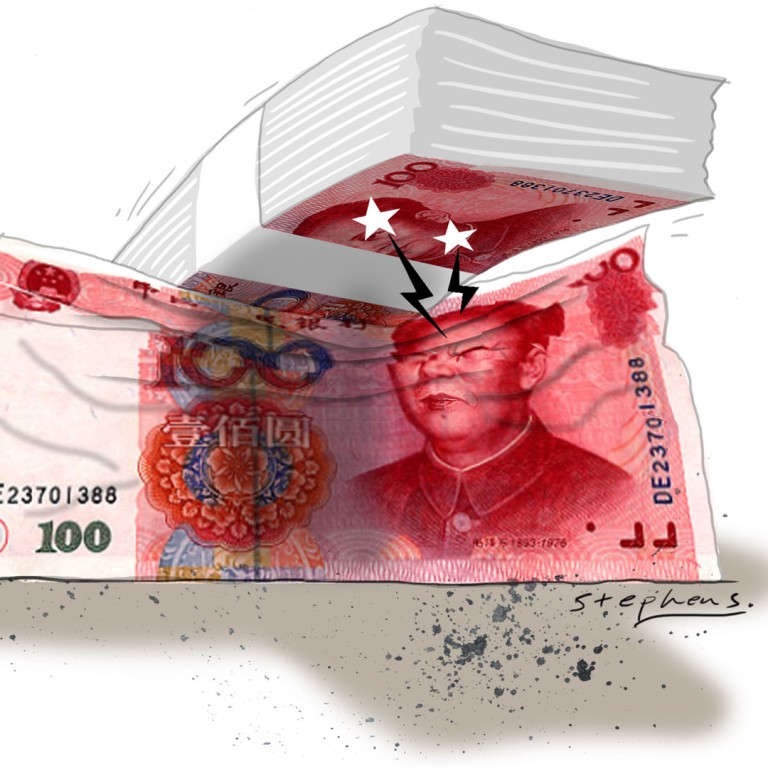
Monetary easing won't resolve China's economic imbalance
Andy Xie says China can no longer monetise away its bad credit decisions, as it did when the economy was smaller and simpler. Quantitative easing only delays the inevitable: painful reform
China may have already begun its own version of quantitative easing, putting local government debts directly or indirectly onto the central bank's balance sheet. Corporate and financial-sector debts could eventually make their way there, too. As quantitative easing in the US, Japan and the euro zone has led to currency devaluation in those places, stability of the renminbi could soon become a challenge.
Since 2008, China's M2 money supply has tripled and debt has quadrupled, while nominal gross domestic product has doubled. The massive leveraging in such a short time span reflects the rise of a gigantic property bubble. As China's credit system functions on collaterals, when land prices are surging, credit and money supply accelerate too, which further inflates land prices. The spiral is the reason for so much debt in such a short period.
China's domestic debt is likely to reach 300 per cent of GDP, with 230 per cent of it in the real economy and 70 per cent financial sector debt. The mountain of debt is primarily with local governments and property developers.
The land market is pretty much dead in most cities. If appraised realistically, over 90 per cent of developers may already be effectively bankrupt. But, in China's government-controlled financial system, they have merely become zombies.
As property developers have become zombies, so too have the local governments they finance. Some local governments, even among the rich coastal provinces, have trouble paying their employees and are resorting to squeezing businesses to prepay their taxes to stay afloat.
Obviously, something has to be done about liquidity for local governments. But, should it be just about money? If the debts are merely forgiven, the same would surely happen again, as it has many times before. Further, if sound reforms are not undertaken, the quantitative easing is likely to lead to a devaluation of the renminbi, as has happened to the dollar, euro and yen. In the case of China, currency devaluation has unpredictable consequences for domestic stability. In the past, every significant devaluation has been followed by some social instability.
China's economic success between 1994 and 2002 had much to do with its hard currency policy: depreciation pressure was alleviated through structural reforms to boost competitiveness. But, the depreciating dollar after 2002 gave China the opportunity to become more inefficient without worrying about the exchange rate. As the dollar reverses its trend, the consequences of the poor policy decisions of the past are all beginning to bite.
Before 1994, China monetised bad credit decisions and accepted devaluation. Will it revert to this habit?
There are two differences between now and pre-1994. First, the amount of debt is much bigger. Before 1994, China's financial system was very shallow. Devaluation would trigger goods inflation quickly, with limited long-term financial implications. The large financial system today means that a substantial devaluation would have a big impact on household wealth. Many who have made it into the middle class could be pulled back.
Second, China is now the largest export economy in the world. Two decades ago, exports were a fraction of today's level. Devaluation today would surely trigger a tsunami in the global financial market. A political backlash in major trading partners like the US would be likely. A potential trade war would be very bad for China.
Further, without structural reforms, quantitative easing cannot revive credit growth, as experience in the US, the euro zone and Japan show. It merely stops the credit system from contracting.
As local governments and property developers become zombies, their suppliers, such as construction companies and equipment manufacturers, will become zombies, too. Quantitative easing would merely bring stability by destroying growth.
A zombie economy cannot support further expansion. The stock market bubble is filling the gap temporarily; inflated stock prices could be pledged as collateral to support credit creation. This continuing credit growth means that dealing with the consequences of a property bubble burst can be postponed.
But, the stock market bubble is likely to burst this year. What then?
China's economic tasks are: one, to deal with the consequences of the property bubble; and, two, to reach a sustainable balance between investment and consumption. The numerous micro problems that many analysts like to point out stem from these two macro challenges. When the macros are healthy, most micro problems will just go away. It is sad to see that the government loves to talk about micro problems and takes no action to deal with their macro origins.
China still has potential. The current per capita income, merely a fifth of the level of advanced economies' and 20 per cent below the global average, is far less than Chinese workers can achieve. A good economic system could quickly bring China's per capita income to half the OECD level. To get there, China must increase household consumption from one third to 60 per cent of GDP and reduce fixed asset investment from half to 30 per cent of GDP.
Playing with money, such as through quantitative easing, merely postpones the day of reckoning. Without structural reforms to boost investors' willingness to pay for the future, the hidden non-performing loans will bring down the financial system. Being clever is just not enough. China must accept the pain that comes with real reforms.

